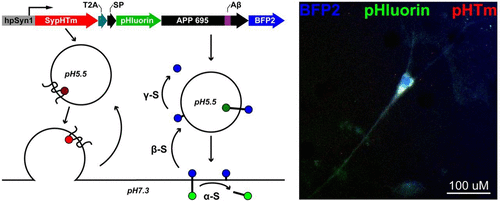当前位置:
X-MOL 学术
›
ACS Chem. Neurosci.
›
论文详情
Our official English website, www.x-mol.net, welcomes your feedback! (Note: you will need to create a separate account there.)
The Fate of Nascent APP in Hippocampal Neurons: A Live Cell Imaging Study.
ACS Chemical Neuroscience ( IF 5 ) Pub Date : 2018-06-21 , DOI: 10.1021/acschemneuro.8b00226 Claire E DelBove 1 , Xian-Zhen Deng 1 , Qi Zhang 1
ACS Chemical Neuroscience ( IF 5 ) Pub Date : 2018-06-21 , DOI: 10.1021/acschemneuro.8b00226 Claire E DelBove 1 , Xian-Zhen Deng 1 , Qi Zhang 1
Affiliation

|
Amyloid precursor protein (APP) is closely associated with Alzheimer's disease (AD) because its proteolytic products form amyloid plaques and its mutations are linked to familial AD patients. As a membrane protein, APP is involved in neuronal development and plasticity. However, it remains unclear how nascent APP is distributed and transported to designated membrane compartments to execute its diverse functions. Here, we employed a dual-tagged APP fusion protein in combination with a synaptic vesicle marker to study the surface trafficking and cleavage of APP in hippocampal neurons immediately after its synthesis. Using long-term time-lapse imaging, we found that a considerable amount of nascent APP was directly transported to the somatodendritic surface, from which it propagates to distal neurites. Some APP in the plasma membrane was endocytosed and some was cleaved by α-secretase. Hence, we conclude that surface transportation of APP is a major step preceding its proteolytic processing and neuritic distribution.
中文翻译:

新生APP在海马神经元中的命运:一项活细胞成像研究。
淀粉样蛋白前体蛋白(APP)与阿尔茨海默氏病(AD)密切相关,因为其蛋白水解产物形成淀粉样蛋白斑块,并且其突变与家族性AD患者相关。APP是一种膜蛋白,参与神经元发育和可塑性。然而,尚不清楚如何将新生的APP分配并运输到指定的膜室以执行其多种功能。在这里,我们采用了双标签APP融合蛋白与突触囊泡标记的组合,以研究合成后立即在海马神经元中APP的表面运输和裂解。使用长期的延时成像,我们发现大量新生的APP被直接运输到体树突状表面,并从该表面传播到远端神经突。质膜中的一些APP被内吞,而另一些被α-分泌酶裂解。因此,我们得出结论,APP的表面运输是其蛋白水解加工和神经分布之前的主要步骤。
更新日期:2018-06-05
中文翻译:

新生APP在海马神经元中的命运:一项活细胞成像研究。
淀粉样蛋白前体蛋白(APP)与阿尔茨海默氏病(AD)密切相关,因为其蛋白水解产物形成淀粉样蛋白斑块,并且其突变与家族性AD患者相关。APP是一种膜蛋白,参与神经元发育和可塑性。然而,尚不清楚如何将新生的APP分配并运输到指定的膜室以执行其多种功能。在这里,我们采用了双标签APP融合蛋白与突触囊泡标记的组合,以研究合成后立即在海马神经元中APP的表面运输和裂解。使用长期的延时成像,我们发现大量新生的APP被直接运输到体树突状表面,并从该表面传播到远端神经突。质膜中的一些APP被内吞,而另一些被α-分泌酶裂解。因此,我们得出结论,APP的表面运输是其蛋白水解加工和神经分布之前的主要步骤。



























 京公网安备 11010802027423号
京公网安备 11010802027423号